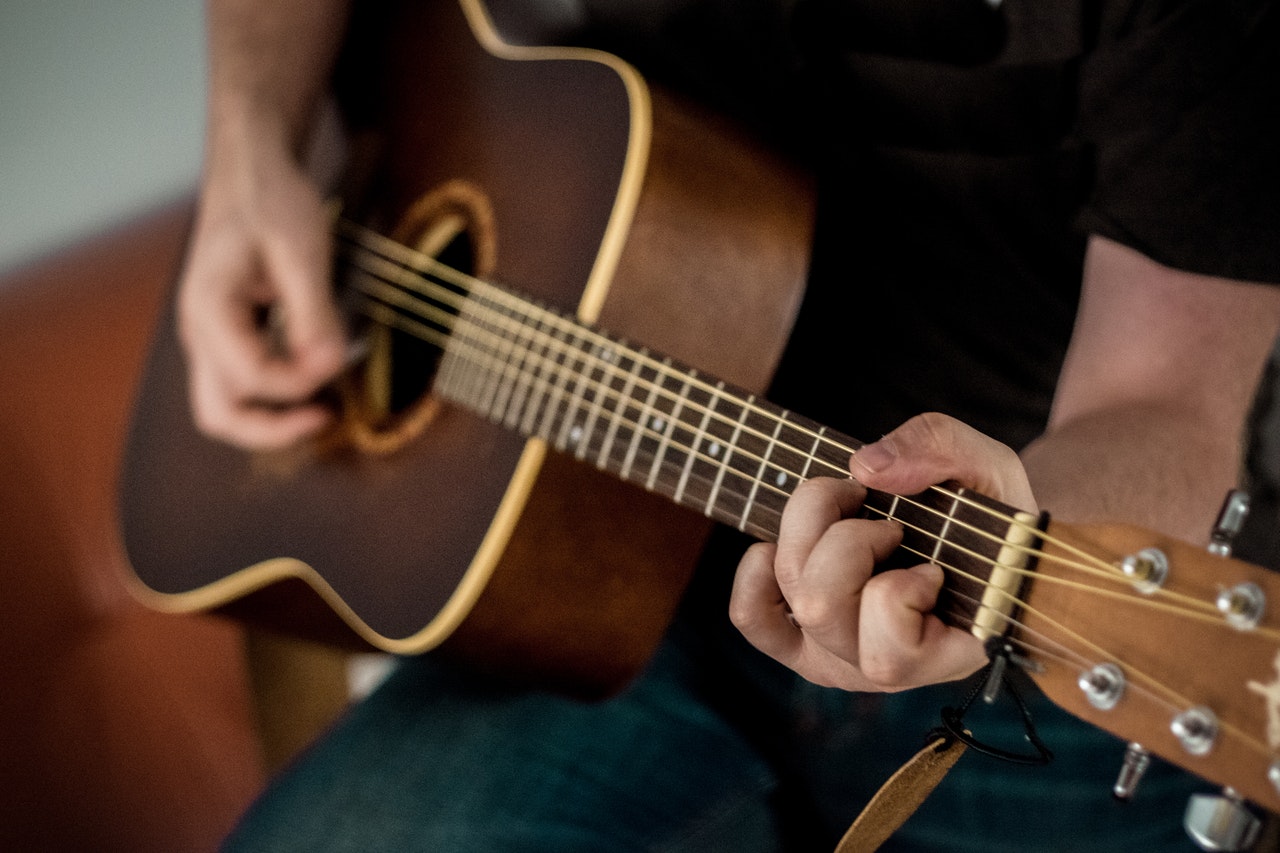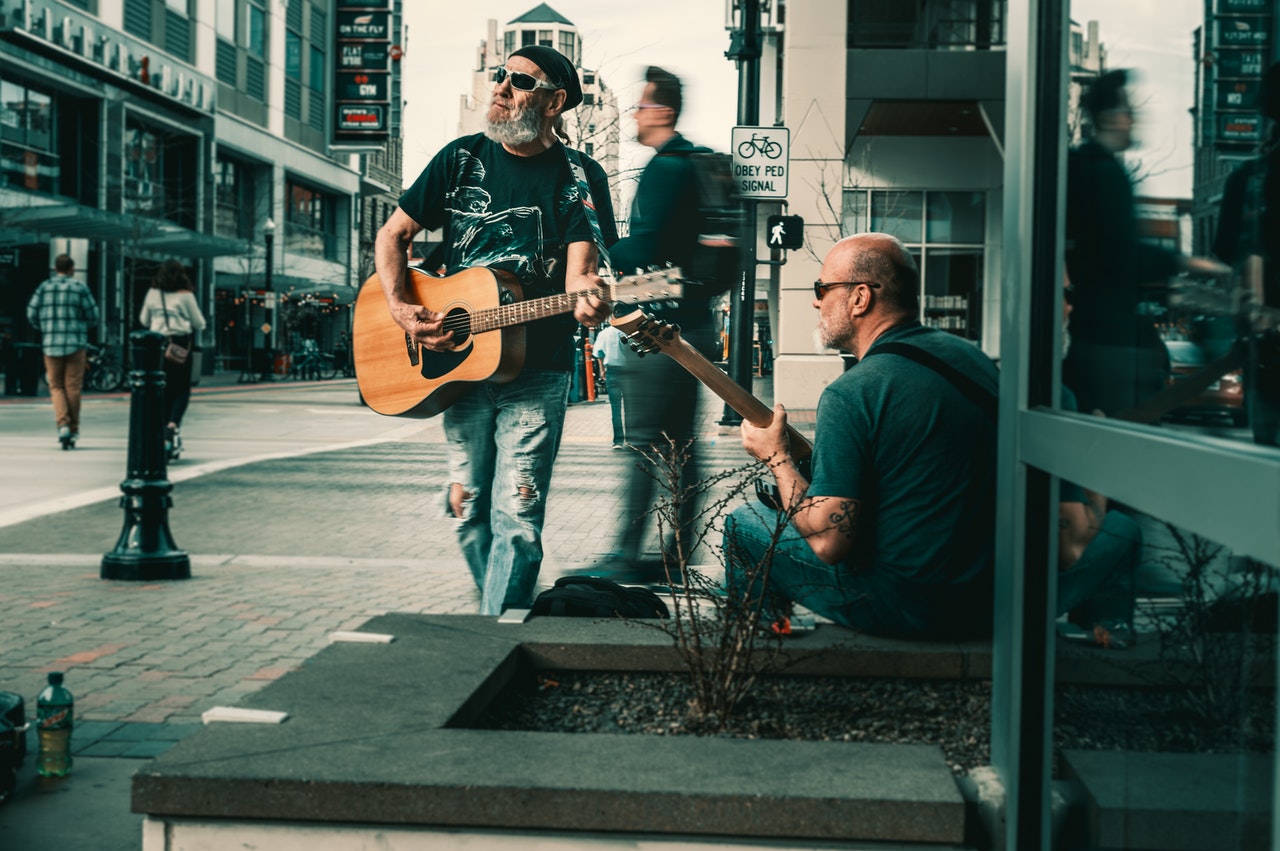Mike Mullins Gives Us A Little Mandolin Music
Share
Neil: Well we have here my friend Mike Mullins and we’re looking at his other… His actual main
instrument of choice is a Mandolin. He hasn’t playing the Mandolin for… I don’t know?! Mike? When did
you just take up the Mandolin?
Mike: Oh, it’s been at least 35 years now and I got… I think was 19 when I started or 21 when I started
playing the Mandolin. I was a frustrated guitar player. So I just felt like I was stuck in one gear and I’ve
heard some music. Some various types of music blue grass music, I’d heard David Grisman who delivers
time and music. Great Mandolin Player and I just became interested in that style. Plus I’ve met a friend I
still play with named Bill Gryphon in the cash valley gryptors who was the first really good mandolin
player I saw up-close and personal and I’m just caught on fire about playing the Mandolin. So I started at
that time and plus I… With the guitar I was just not progressing the way I wanted and so I kind of… I
never really completely stop playing the guitar but I did gravitate toward the Mandolin and I found out
that in some ways it came more naturally giving the guitar and plus the world has many Mandolin
players out there so something just a little different and it actually… Ultimately when I went back to the
guitar, I started playing more guitars it has helped. I found it to make my right hand stronger and more
accurate and I just…. I was able to… You know, Even though the fingering was totally different, the time I
spent on the instrument was well spent and it actually made me better on guitar in the long run. I was…
You know I was always struggling that… (Laugh) When I was learning to flat it I was kind of struggling
with my right hand on the guitar and when I got onto the Mandolin it was a very similar technique. That
it transfer back to the guitar pretty well. So yeah, I just really still enjoy this instrument quite a bit and…
Neil: Yeah.
Mike: …and it’s a lot of fun and…
Neil:
So how’s the tune?
Mike: Well, it’s tuned in 5th it’s tuned the same as a violin. From the top down it’s E-A-G and G and you
just… So there’s 2 of each note though. You know, you can learn unison I mean people send them to do
it’s called cross tuning where you’re 2 in a string a different note and did a… (Guitar playing)
Neil:
Wow.
Mike: But I did a… So, I do a thing called split string where I use a nail to it (Guitar Playing) one of
them. But generally they both threaded at the same time and that’s… Kind of it gives a Mandolin its
characteristic sound as… If you were to string this which has one of these strings will sound really terrible
that wouldn’t be much terrible if something about having the tune was in strings together. There’s
almost the slight delay of the ear doesn’t constantly pick up on but it gives the fullness you know (Guitar
Playing) so with…
Neil:
It kind of built on tremolo of on the preserving sense because when you hit the 2 notes you
really don’t hit them exactly at the same time. So there’s a slight delay.
(Guitar Playing & Voices Overlapping)
Mike: There’s a slight delay…
Neil:
That also means that’s slightly out of place even though they’re on the same notes. So…
Mike: Exactly.
Neil:
So that’s what you get with the double string like the 12 string guitar?
Mike: Yes you do and it just creates different… You know. Just a different I don’t know?! It’s just over
tones but it does do something with the sound where it just doesn’t work really well to have just in a
single string so they’re in courses. But I’ve also known players who string the bottom two strings on
octaves so it sounds kind of like (Guitar playing) this tone. It’s kind of what it sounds like.
Neil:
Yeah.
Mike: if you do that. But I’ve never really done that and do that with the Mandola which is the
counterpart of the Viola. It’s slightly large in the Mandolin and it tuned 1/5 lower. You got A-E-G and
then there’s C you know 1 octave below that C
Neil:
Alright.
Mike: on the Mandola and I used to string that one in octaves as for the little strings that gave it kind
of a really interesting sound. But…
Neil: Yeah. So you… Even those that register like the lowest string you have there. The G is the sound
of broken 3rd string on the guitar?
Mike: Exactly. Yeah.
Neil:
And then the high E string is like the E in the 12th fret of the high E note.
Mike: Yes 1 octave above the E on the guitar ring.
Yeah. So the register is way above guitar range (Guitar Playing) yeah. So…
Neil:
Mike: Yeah it is. It’s and again it’s the same as the violin. It’s the same tuning.
Neil: Yeah. And then you do a lot of the same stuff. You do on a guitar… Like you played, you can play
rhythm you can play chords.
Mike: Yeah,,,It’s a little different technique on the guitar you… Especially in blue grass or folk and you
tend to use a lot open ringing kinds of chords you know. That resonate and on Mandolin you can do that
too! Depending on the styles (Guitar Playing) that just open change chords (Guitar Playing) or A (Guitar
Playing) on blue grass you might want the Mandolin is kind of the back beat you know… It’s like kind of
just driving force behind of the basics that down downbeat that the Mandolin hits the backbeat so in
blue grass you tend to play more close position kinds of chords. You get that percussive effect where
you’re dumping the string. You’re kind of holding this close position chords. This is going to be an A (ting
sound) and then (Guitar Playing) and that’s kind of what you see a lot of in blue grass. You know, your
sort of squeezing and releasing on the neck too (strum) so you’re not just going (Guitar Playing) this one.
If you want percussive effect and that’s kind in a rock soft done much slower than that.
Neil:
Mike: Yeah.
Neil: The backbeat it beats 2 and 4 of the measure. And that’s what you are doing you’re answering
the base.
Mike: Exactly. Yeah.
Neil:
Just out of step with them. Answering “bomp bomp” it’s the whole boom chop thing that you do.
Mike: It is.
It’s hard…
Neil:
Mike: It’s divided between the…
It’s the half of it.
Neil:
Mike: Yeah.
It’s the chop.
Neil:
Mike: It’s the chop. This is the…
Yeah.
Neil:
Mike: The up chop, no… (Laugh)
Neil: Yeah So… And then you course play melodies on it. Cause’ especially if its register it really cuts
through all the baseness of guitars and bases and all kind of the stuff.
Mike: Yeah.
The Mandolin takes the melody… It’s really clear…
Neil:
Mike: Yeah. Blue grass music was originated by Bill Monroe who first of the Mandolin player and he
kind of popularize the style of Mandolin. This is a Gibson Mandolin from the 1930s, 1937 actually and it’s
a model called an F7 and it has been remapped many years ago a longer F5 style which is the… You
know, I can get in all the Gibson and nomenclature. But basically this Mandolin was converted to an F5
an F7 is a slightly shorter neck. You know, it joins the body in the different spot…
Neil:
Oh…
Mike: And 12th fret instead of 15th. But the problem with those instruments is… It put the bridge on
the wrong place. On this F-hole Mandolin is the bridges was truly located centrally on the top right
around the point of these F-holes and with the shorter neck with the joints lower down the neck. The
bridge had to be here… Well that generally didn’t sound very good. So, some of these were converted.
People aren’t doing that anymore cause’ it kind of ruins the collectability factor. But that made it the
better sounding instrument. It was like this one. I got it… I got this one in 1991 and I just love the way it
sounds. You know, I’ve had others… But this is the one I kept and yeah… I kind of lost the trail of your
question there. You know I started…
Neil:
It was playing chords in the rule of the boom chuck thing?
Mike: Yeah. (Guitar playing)
Neil:
I’m talking about that. Even in the first place the melody on it was the…
Mike: Well yeah.
Neil: And you know blue grass is to… (Guitar playing) when you take the melody it’s really up in the
high register and then they just stand out from all the…
Mike: Well yeah… You can do you know (Guitar Playing) and then you can do (strum) Ah gosh! Yeah the
lowest you can get was G (Guitar Playing) you kind of use this as a drawn but generally you’re doing a lot
of stuff a neck you know… (Guitar Playing) But… Yeah… The high notes do kind of stand out. It is the high
instrument with the highest register it’s like you know a bit old… You know…
Neil:
(Agreed)
Mike: But the flap… Flap instruments, this is the one that gets you up there as high as you can get.
Neil:
Yeah.
Mike: And gets rise…
Neil:
Yeah. Is there much… What’s out there for solo Mandolin?
Mike: Well, solo Mandolin. There’s… there’s a whole style of Mandolin playing originating when
Mandolins are very very popular during about… The World War 1 era and before where there was like a
du… It’s called a duo style where you kind of get a (Guitar Playing) it almost sound like 2 instruments
string. You’re just doing kind of alternating tremble of thing with a string that’s below it. But I play a few
solo pieces. Generally I’ve been working on ensemble player but its fun to do some things as far as solo
stuff. I play a little tiny bit of something I don’t know which time we have. I’m just a too little… Wanting
to do a little sample…
Sure, take your time.
Neil:
Mike: Well, this is what everyone’s hearing I think and I kind of arrange this. Well, I loosely arrange it
for a solo Mandolin it’s something you can do with a beside stick to stay doing a little tune…
Right.
Neil:
Mike: So… And it incorporates that (strum) split string technique I was talking about. (Guitar Playing) so
that one basically…
Oh my God–. That’s stunning! Absolutely stunning!
Neil:
Mike: There’s guys out there who are really good at that style. I’m sort of just a neophyte at only very
recently I’ve been trying to do stuff like that…
Yeah.
Neil:
Mike: You know I’ve… Cause’ most of my kind of play are kind of blue grass and contemporary styles on
the Mandolin and we have some little swing music just… You know, just I’m very heavily to David
Grisman.
Yeah.
Neil:
Mike: And then there’s other players too… There’s a… You know the… There’s Sam Bush, and Christy
Lee, And you know… Adam Steffey and John Reischman. These are all stellar players there in styles but
now was music guy named Evan Marshall who does great solo work. I mean, he did… Swear it’s like 2 or
3 instruments playing…
Neil:
Yeah…
Mike: And you know… But that… You know I’m using the pick along with my (ting sound) my middle
finger that kind of…
I saw you do that you know you’re basically… There was something picking in there.
Neil:
Mike: Yeah.
It cause of almost a double stop type of ideas but…
Neil:
Mike: Yeah and my nail broke the other day so it’s like… It’s not quite as even as it could be but you
know so that… That’s a kind of stuff I’m sort of fooling around with an hour were things like that. But
generally I do a lot of… A lot of feltings type. Suppose I love the playing I much love playing the feltings
like playing…
Neil:
Yeah.
Mike: I like playing blue grass. I like… I just like sitting around playing with people who were even not
playing blue grass… You know, they’re gonna’ just doing a regular contemporary song and all just playing
Mandolins was just a lot of fun.
Neil:
Yeah.
Mike: So, this is a… Mandolin has been kind of a… It has helped me to make me a better guitar player
and you know… Kind of at a time I just often wondered if I hadn’t taken with the Mandolin if I wouldn’t
gotten frustrated enough to even actually stop playing the guitar for awhile.
Neil:
Wow.
Mike: I don’t know. It really… it was an inspiring instrument to take up and…
Neil:
Yeah…
Mike: And a lot of really great players out there right now who taking up this instrument and getting it
taken in places where it hasn’t been in about 80 years because… Where…. You know, beyond blue grass
I mean and…
Neil:
So it was… It came. I mean it was used in Italy obviously around World War 1 before…
Mike: Well yeah. There was the Gush Back in the middle times. There was an instrument called a
Mandola which is the pre-course of the Mandolin and then the Neapolitan style of Mandolin is the rib
bullback model. You know they have a very sweet sound. Better for you know… Like a… More like
classical music like you can find in classical recordings of players using the old bullbacks. And then the
Gibson Company started making them carved Mandolins in the late 1800s and they were built more on
violin principles.
Neil:
Yes.
Mike: First with an oval sound holes and then in the early 20s Gibson… There was engineering Lloyd
Lore along… Either other people involved in this two but they thought: “Why not take the violin
principles” step further and will use F-holes and we’ll have a can’t deliver finger board that is actually not
attached to the top. Like a violin it’s elevated it doesn’t touch the top. So the top can vibrate more freely
and… So, they came up with this concept. And actually there was a company. There was a Mandolin from
about 1913 that have F-holes, a little company called shoot or shot (Chutt or Chutt) I don’t know how to
pronounce it’s like C-H-U-T-T and it have the sort of an A-style you know…
Neil:
Tear drop….
Mike: tear drop shape Mandolin with F-holes. The great very small numbers. I do actually see one for
sale recently on some website and that was really interesting piece of history cause’ Gibson is kind of
incredible with the F-hole style. The F-hole style Mandolin kind of… Gibson Mandolin a lot of depth and
of penetrating quality. Much like an Archtop guitar, very percussive.
Neil: Yeah.
Mike: Cause’ the top vibrates differently for certain kinds of music around all Mandolin is better. A lot
of Irish and old time musicians perform the round hole sound. It’s a very. It’s a very very open sound.
Probably little more sustain on those…
Neil:
Mike: Absolutely more sustain (Guitar Playing)
That’s what you get with this (strum) a quick attack… In a quick to K.
Neil:
Mike: Yeah.
on Archtop Guitar.
Neil:
Mike: Pretty much. It’s similar. I think these are little more versatile, they’re louder, and that if you try
to play blue grass on a round hole Mandolin the chop chord is we called them (Guitar Playing) It don’t
really stand out. They get kind of muffle. But that was not really what they’re for and….
Alright.
Neil:
Mike: And when they were invented, blue grass music didn’t exist.
Neil:
Right. (Laugh)
Mike: And when these were invented. They were… The style… They were generally regarded to be
orchestral type instruments for playing classical music and to be a solo instrument and ensemble. The
Mandolin orchestra is the very popular until about 1920. And shortly after that this Mandolin style came
about. It was kind of ironic at the time. Nobody wanted them because the Mandolin boom, ended about
1921 and this Mandolin came in the… Being about 1922. So they built the greatest Mandolin known to
man generally.
Neil:
Yeah.
Mike: That acknowledges the F5 style is the ultimate mandolin at the time when nobody wanted
Mandolins. Nobody is playing Mandolins anymore and… So it was just a little bit… After its time, I mean it
was like nobody wanted it. It was like George Green I think said that you can. You know, you
can… “Invent the greatest buggy whip in the world but nobody’s going to want it after the motor car was
invented or people stopped.”
Neil:
Yeah.
Mike: You know… It was in restaurant carriages but that one Bill Monroe came along and…
So when was that?
Neil:
Mike: 19… Well, in the 30s he began experimenting with it. With different kinds of music. He had a
sound in mind but he wasn’t sure at that time what it was going to’ be. But when he bought his F5
Mandolin as a used instrument in 1941 and pretty much used that to define his sound.
Neil:
Hmmm…
Mike” Then these Mandolins become popular again at least among you know… Blue grass players and
then in the other styles of music I mean this type was. This is the kind, you kind of seen most often as far
as the modern Mandolin is this style. And there are other builders who modify the body style of it but it’s
generally the same sort of construction, archtop with F-holes.
Ahmm…
Neil:
Mike: And the oval sound hole once were still very much involved to. If you want, if you want it more
open old time, a kind of sound… A rug tiny kind of thing…
Yeah.
Neil:
Mike: I’ve got one at home it’s very nice from 1923.
Yeah.
Neil:
Mike: The an A style…
Neil: Yeah. You know cause’ I know a record held a long time ago was a bunch of classical music it’s
written in Beethoven wrote some stuff of the Mandolin
Mike: It did? Yeah.
Neil:
And Vivaldi he did…
Mike: Yeah?
Neil:
I think that was 200 years ago and so…
Mike: (Guitar Playing) absolutely yeah.
Neil:
Yeah…
Mike: Beethoven knows the Mandolin. He used to play it you know… There’s a couple things on it.
Yeah…
Neil: Ha. Oh yeah. So that’s kind of different way back. So, I didn’t realize that blue grass as we now
know it was even that new. I mean that obviously grew out of shunting kind of music to reserve its style.
Mike: It didn’t. It did a mapped music…
and it record folk music?
Neil:
Mike: and, and… You know but for blue grass there was occurred of family and there were some. There
were kinds of some old time string bands… That were, you know country music started getting as they
knew of them. Starting getting popular in the 20s, you know you had Jimmy Rogers the singing brave
man. You have the various cowboys singers like Gina Laughtry and Roy Rogers and these… Well yeah
kind of out grows of country or mountain music at the time and then Bill Monroe was kind of
assimilating all of these… And he also listens to listen like blue singers you know… African-American blue
singers at the time and he incorporated some of that into his music. There’s a lot of blue, it’s in blue
grass and he experimenting with like… He had an accordion for awhile he had various different
instruments and then. But when he started playing his F5 Mandolin… Is kind of when you know… He
went off of his own… You know his brother Charlie had a band for during the 30s and then they stop
playing together who I think kind of a falling out… (Laugh) And then its smooth sound was defined on F5
Mandolin…
Neil:
Okay. Yeah. (Laugh)
Mike: So… (Guitar Playing)
Neil:
So that really just as World War 2?
Mike: Yeah! Relatively….
Neil:
it’s kind of what…
Mike: and music. And then other players, other musicians started you know playing blue grass.
Neil:
Alright…
Mike: And then also.
Neil: So when people like Grisman come along and kind of modify it and make it half jazzy and half
swing… And that kind of stuff at this point that’s been around for…
Mike: (Laugh)
Neil:
So that was the 70s?
Mike: Yeah I know…
Neil: Early 70s he was doing that so it was not… It wasn’t like he’s taking a 100 year old tradition and
weakened it and he has taken a 30 year old tradition.
Mike: Yes. Yeah.
or he’s even 20 by the time and he was messing around and they’re only been around…
Neil:
Mike: Yeah, I mean he started playing in the early 60s and you know… Or maybe a little before that but
he was totally into Bill Monroe and there’s another Mandolin player name Frank Wakefield who was
kind of a Monroe disciple…
Neil: Oh yeah.
Mike: Who Grisman was really into and.. And then someone in the late 60s started kind of doing his
own thing and writing things that were sort of blue grass like but they had… You know, they had Leonore
Wilson skills and you did normally hear in blue grass…
Neil:
Right.
Mike: and out of that came. You know, for like a better tune of old music like which is kind of out of his
nickname. You know, and there was this music he was writing and performing with acoustic instruments
but no one really knew what to call it. You know, it wasn’t really jazz it wasn’t really blue grass it wasn’t
really film music it had a swing to it too. It had a…
Neil:
Yeah…
Mike: It combined elements of like Django Reinhardt along with you know things you’d hear maybe a
blue grass and some of it are very blue grass and some of it more jazzy. And…
Neil:
Alright.
Mike: and there was… Technically a catch of raise were…
Neil:
Yeah.
Mike: Many of it a lot of in Latin influences a lot of like Sambas.
Neil:
Right.
Mike: And different meters that dumped here in folk music and so just became encapsulated of dot
music.
Neil:
Yeah yeah.
Mike: (Laughing)
It’s really neat and really…
Neil:
Mike: (Guitar Playing) I listen to a lot of that for years and tried doing how to play it with varying
degrees of success and failure (Laugh)
Yeah. Well because honestly harmonically it’s a lot more complex than blue grass stuff.
Neil:
Mike: Oh yeah, yeah… You know, you know it could be …
artistically and everything…
Neil:
Mike: Yeah. You know it’s a… It’s hard. It’s almost as hard in a way that just to play Monroe style really
right and as it is to play you know like Grisman’s style with its more ornamented stuff you know. It’s just
kind of whatever style it is you know to do it really well requires a lot of work. Even one might sound
harder than another in you know… Some styles might be easier to get into you know like… It might be
easier to get into a Monroe style initially than to play something that’s really out there that has like. Like
lines in it that it would be sound at home and trying to practice with saxophone. So Something like that.
Neil: Yeah. I didn’t even notice to play an earlier sign or playing the earlier second. You know that
when we…
Mike: (Laugh)
Neil: just took a little bit of a lead. You know there’s definitely had a characteristics that sounds like
you’re playing the Mandolin or the… Or the guitar is really cool…
Mike: Well,
It sounded so different with the one I was doing is a little bit more awkward and you know.
Neil:
Mike: Yeah. I sort of you know got into… When I started playing like lead stuff it was more from a blue
grass in some point…
Yeah.
Neil:
Mike: And as far as the Mandolin. Like a Mandolin was a… I do a lot of things that are across the strings
like a (Guitar Playing) ah so, sorry I’ll do that again (Guitar Playing) or (Guitar Playing) I kind of adapt in
the guitar. That’s kind of like I almost remember a McReynolds style. Jessie McReynolds is a…
I was going to say is a Van Halo style…
Neil:
Mike: (Guitar Playing) (Laugh) yeah… Maybe!
Because it’s Arpeggios
Neil:
Mike: Yeah I was talking of…
And then using cross string things. To while change or something like that.
Neil:
Mike: Yeah. One string still ringing while you’re fretting the next one…
Neil:
Yeah…
Mike: On Mandolin works out really well in just with the notes really. You know stand out. It give this
instrument one thing it does not have is sustained. The only way to get a really sustained note is to do a
really sustained note is doing a tremolo which (guitar playing)
Yeah.
Neil:
Mike: Which (Guitar Playing) and it’s fine but you’re not going to be able to hit them… Like on a violin
you can do a big long bow and
Neil:
Yeah.
Mike: And in guitar. A guitar is an…. Naturally more sustained than a Mandolin…
Yeah.
Neil:
Mike: Especially in the electric guitar you’ll just hit a note and you will go forever. But on a Mandolin
the only thing to make it happen… Sort of an illusion of sustain… Cause’ you’re really doing the (Guitar
Playing)
Yeah.
Neil:
Mike: (Guitar Playing) you’re just hitting a note that’s trying to die…
Yeah.
Neil:
Mike: on you repeatedly. You know there’s always trying to wake the thing up and then you get this
(Guitar Playing) there’s no way to really get the sound (hum) one of this continuous thing…
Yeah.
Neil:
Mike: You know. You result some kind of artificial…
Neil: Sometimes on the guitar (Guitar playing) you can make something really dramatic because of
(beep) whoa! You can make stuff really dramatic because of how it decays…
Mike: Yeah.
Neil: Right. And by stretching out the time a little bit or something. But I don’t know, even though
you’re doing a rainbow a lot of times you would do a little similar things in there and as it got a little
more… You might slow down with a little bit and you will get a little softer so create that. Or you know,
you can really create almost that type of delaying decay too.
Mike: Yeah and part of the Mandolin’s charm is the tremolo of… I mean…
Yeah.
Neil:
Mike: Every cheesy Mandolin song ever written is got the tremolo of. You know.
Neil:
Yeah.
Mike: You have the (Guitar Playing)
Neil: I think if you took that tremolo of effect and applied it to something like Iron man
Mike: (Laughing)
this is how it will “blum blum blum” (Man making sounds)
Neil:
Mike: Yeah… ( Laughing)
or what is that old? Smoke in the water of choosing my classic rock taste
Neil:
(Guitar Playing)
Mike: Piece of the end part there…
Yeah.
Neil:
(Guitar Playing)
Mike: I don’t know if I’m playing it a little right key…
Neil:
(Laughing) can you actually do that in G.
Mike: Oh yes in G. Okay. (Strum)
Neil:
No that’s okay. (Guitar Playing) That is still perfect.
Mike: Yeah?
Neil: Way perfect enough.
Mike: Yeah…
Neil:
For a using one or…
Mike: That was in the…
Neil:
Exclusion.
Mike: (Laughing)
Neil: So anyway… Well, officially that’s kind of fun stuff thanks for taking your time to tell us about
your real… Your most loved instrument probably.
Mike: Well, no problem should I play something to take obscene of…
Neil: Yeah! What do you got?
Mike: Well, obscene of I’ll do… I’ll do a little tune here with really full of green correct name. That I like
to play on a Mandolins of called “Colored Aristocracies”
Oh yeah…
Neil:
Mike: It’s a (strum)
Neil:
I see a finger picking version of you of that…
Mike: Did you really? Wow!
Neil:
Yeah.
Mike: That’s great! You should play that…
Yeah. But I picked up out of my head (Guitar Playing) you know in the first I got right.
Neil:
Mike: Yeah.
Neil: It’s not pretty right timing guitar by stopping in the grocery when it got me some kind of the
finger picking…
Mike: Cool! I wanted you to do that.
Neil:
And it’s like little tunes…
Mike: Yeah it is.
Neil:
Yeah so… I should. You know I just want to thank you Mike for coming out…
Mike: Yeah.
Neil: and then visiting with us today and bringing out his cool Mandolin who were just to make guitar
stuff and things too so will take us out. We’ll see more of totally guitars I’m sure…
Mike: It’s been truly enjoyable, thank you.
Neil:
Sure.
Mike: I have something to contribute…
Neil: This is great! And yeah go ahead take your shot with “Colored Aristocracies”
Mike: Okay (Guitar Playing)
Mike Mullins thanks a lot!









